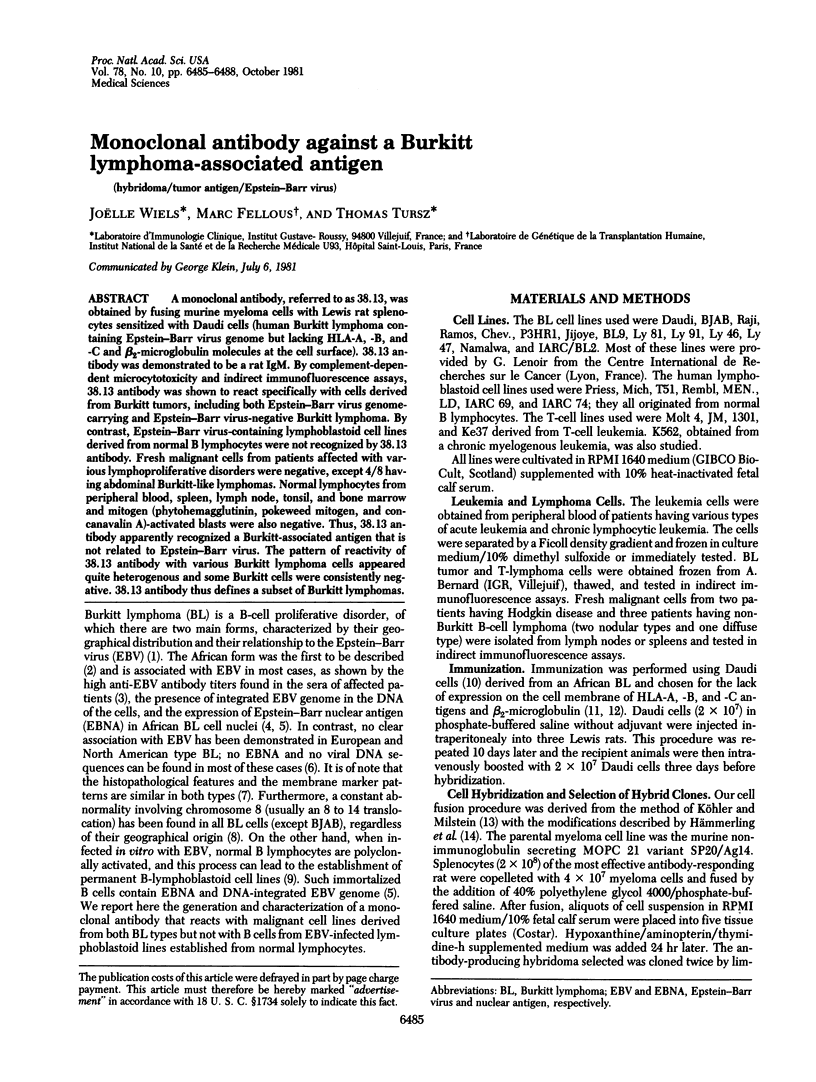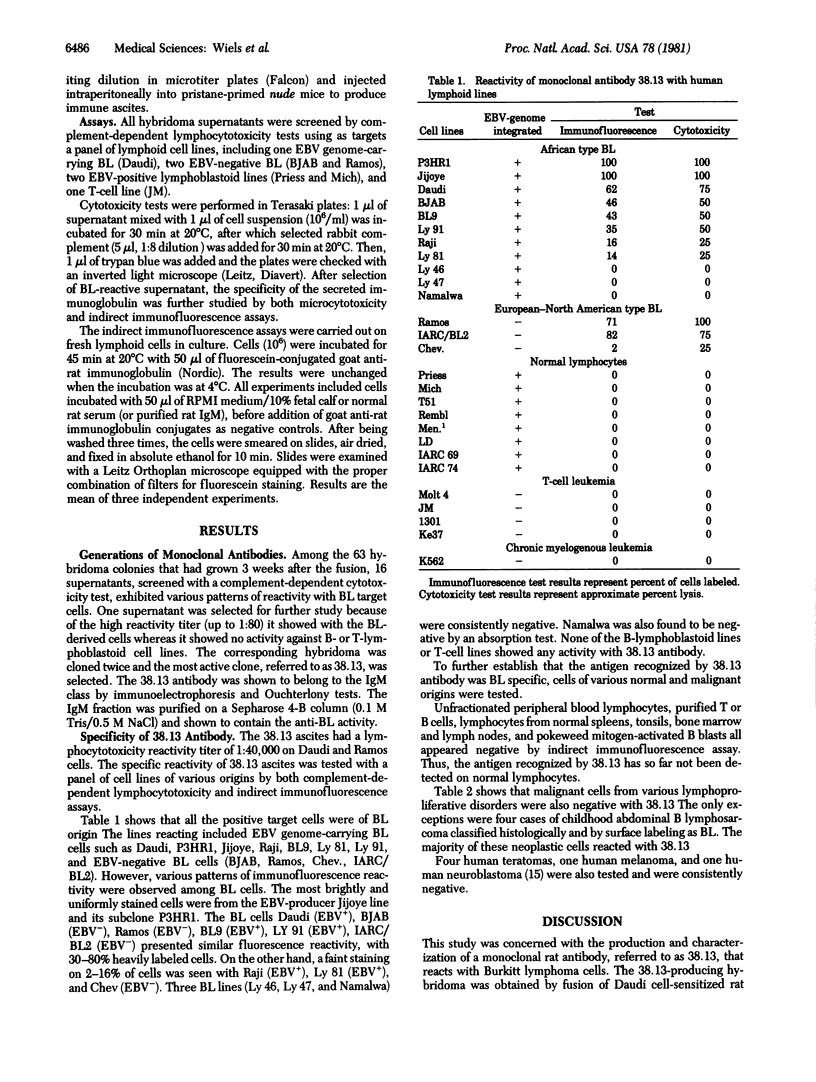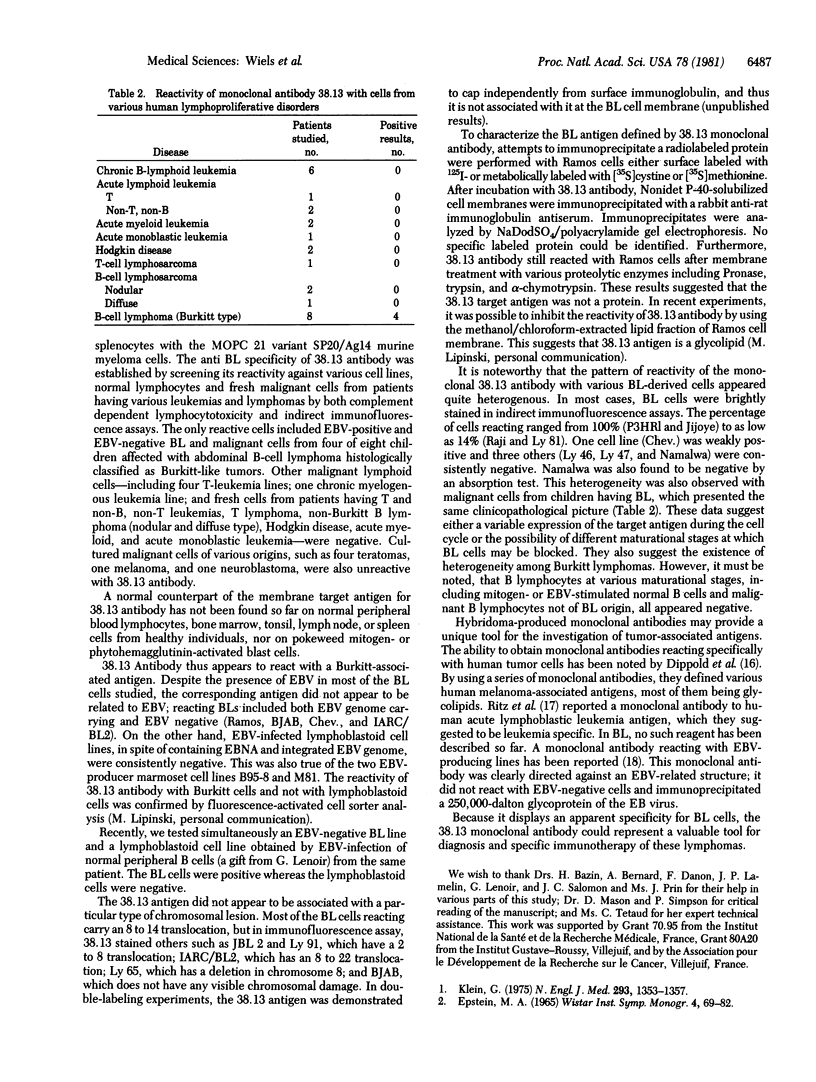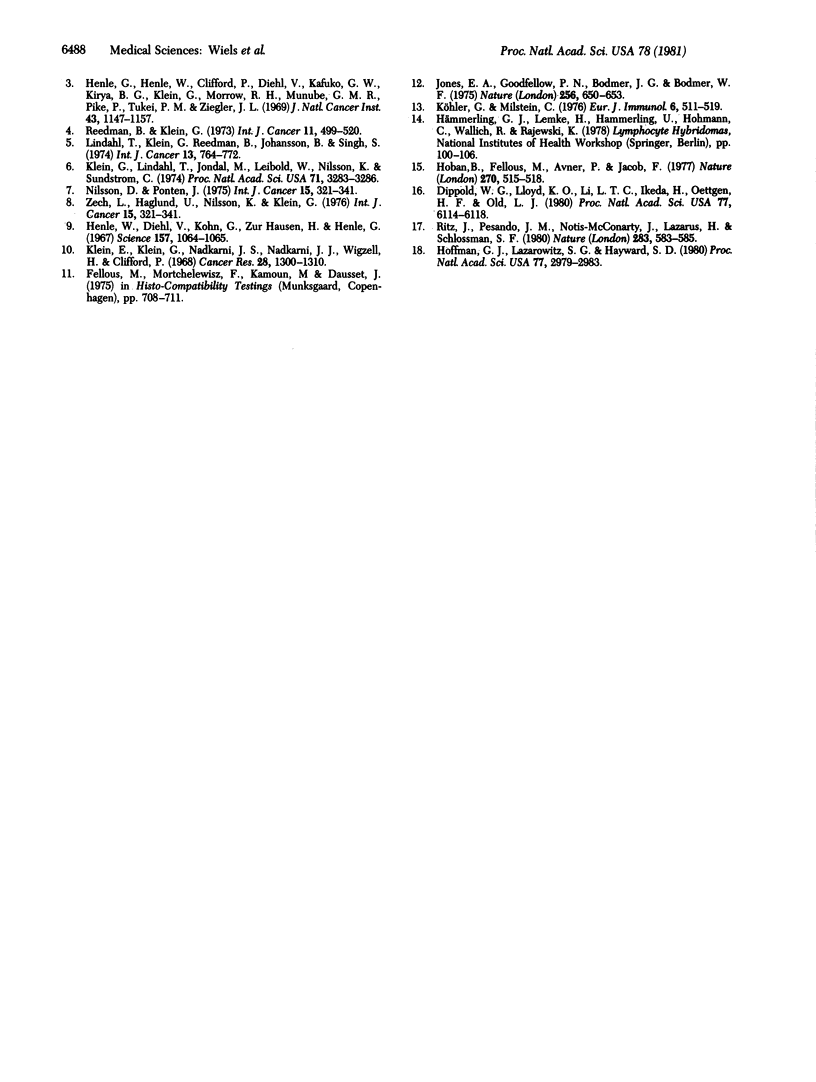Abstract
A monoclonal antibody, referred to as 38.13, was obtained by fusing murine myeloma cells with Lewis rat splenocytes sensitized with Daudi cells (human Burkitt lymphoma containing Epstein--Barr virus genome but lacking HLA-A, -B, and -C and beta 2-microglobulin molecules at the cell surface). 38.13 antibody was demonstrated to be a rat IgM. By complement-dependent microcytotoxicity and indirect immunofluorescence assays, 38.13 antibody was shown to react specifically with cells derived from Burkitt tumors, including both Epstein--Barr virus genome-carrying and Epstein--Barr virus-negative Burkitt lymphoma. By contrast, Epstein--Barr virus-containing lymphoblastoid cell lines derived from normal B lymphocytes were not recognized by 38.13 antibody. Fresh malignant cells from patients affected with various lymphoproliferative disorders were negative, except 4/8 having abdominal Burkitt-like lymphomas. Normal lymphocytes from peripheral blood, spleen, lymph node, tonsil, and bone marrow and mitogen (phytohemagglutinin, pokeweed mitogen, and concanavalin A)-activated blasts were also negative. Thus, 38.13 antibody apparently recognized a Burkitt-associated antigen that is not related to Epstein--Barr virus. The pattern of reactivity of 38.13 antibody with various Burkitt lymphoma cells appeared quite heterogenous and some Burkitt cells were consistently negative. 38.13 antibody thus defines a subset of Burkitt lymphomas.
Full text
PDF



Selected References
These references are in PubMed. This may not be the complete list of references from this article.
- Dippold W. G., Lloyd K. O., Li L. T., Ikeda H., Oettgen H. F., Old L. J. Cell surface antigens of human malignant melanoma: definition of six antigenic systems with mouse monoclonal antibodies. Proc Natl Acad Sci U S A. 1980 Oct;77(10):6114–6118. doi: 10.1073/pnas.77.10.6114. [DOI] [PMC free article] [PubMed] [Google Scholar]
- Epstein M. A., Barr Y. M., Achong B. G. Studies with Burkitt's lymphoma. Wistar Inst Symp Monogr. 1965 Sep;4:69–82. [PubMed] [Google Scholar]
- Henle G., Henle W., Clifford P., Diehl V., Kafuko G. W., Kirya B. G., Klein G., Morrow R. H., Munube G. M., Pike P. Antibodies to Epstein-Barr virus in Burkitt's lymphoma and control groups. J Natl Cancer Inst. 1969 Nov;43(5):1147–1157. [PubMed] [Google Scholar]
- Henle W., Diehl V., Kohn G., Zur Hausen H., Henle G. Herpes-type virus and chromosome marker in normal leukocytes after growth with irradiated Burkitt cells. Science. 1967 Sep 1;157(3792):1064–1065. doi: 10.1126/science.157.3792.1064. [DOI] [PubMed] [Google Scholar]
- Hoffman G. J., Lazarowitz S. G., Hayward S. D. Monoclonal antibody against a 250,000-dalton glycoprotein of Epstein-Barr virus identifies a membrane antigen and a neutralizing antigen. Proc Natl Acad Sci U S A. 1980 May;77(5):2979–2983. doi: 10.1073/pnas.77.5.2979. [DOI] [PMC free article] [PubMed] [Google Scholar]
- Hogan B., Fellous M., Avner P., Jacob F. Isolation of a human teratoma cell line which expresses F9 antigen. Nature. 1977 Dec 8;270(5637):515–518. doi: 10.1038/270515a0. [DOI] [PubMed] [Google Scholar]
- Hämmerling G. J., Lemke H., Hämmerling U., Höhmann C., Wallich R., Rajewsky K. Monoclonal antibodies against murine cell surface antigens: anti-H-2, anti-Ia and anti-T cell antibodies. Curr Top Microbiol Immunol. 1978;81:100–106. doi: 10.1007/978-3-642-67448-8_15. [DOI] [PubMed] [Google Scholar]
- Klein E., Klein G., Nadkarni J. S., Nadkarni J. J., Wigzell H., Clifford P. Surface IgM-kappa specificity on a Burkitt lymphoma cell in vivo and in derived culture lines. Cancer Res. 1968 Jul;28(7):1300–1310. [PubMed] [Google Scholar]
- Klein G., Lindahl T., Jondal M., Leibold W., Menézes J., Nilsson K., Sundström C. Continuous lymphoid cell lines with characteristics of B cells (bone-marrow-derived), lacking the Epstein-Barr virus genome and derived from three human lymphomas. Proc Natl Acad Sci U S A. 1974 Aug;71(8):3283–3286. doi: 10.1073/pnas.71.8.3283. [DOI] [PMC free article] [PubMed] [Google Scholar]
- Klein G. The Epstein-Barr virus and neoplasia. N Engl J Med. 1975 Dec 25;293(26):1353–1357. doi: 10.1056/NEJM197512252932607. [DOI] [PubMed] [Google Scholar]
- Köhler G., Milstein C. Derivation of specific antibody-producing tissue culture and tumor lines by cell fusion. Eur J Immunol. 1976 Jul;6(7):511–519. doi: 10.1002/eji.1830060713. [DOI] [PubMed] [Google Scholar]
- Lindahl T., Klein G., Reedman B. M., Johansson B., Singh S. Relationship between Epstein-Barr virus (EBV) DNA and the EBV-determined nuclear antigen (EBNA) in Burkitt lymphoma biopsies and other lymphoproliferative malignancies. Int J Cancer. 1974 Jun 15;13(6):764–772. doi: 10.1002/ijc.2910130605. [DOI] [PubMed] [Google Scholar]
- Nilsson K., Pontén J. Classification and biological nature of established human hematopoietic cell lines. Int J Cancer. 1975 Feb 15;15(2):321–341. doi: 10.1002/ijc.2910150217. [DOI] [PubMed] [Google Scholar]
- Reedman B. M., Klein G. Cellular localization of an Epstein-Barr virus (EBV)-associated complement-fixing antigen in producer and non-producer lymphoblastoid cell lines. Int J Cancer. 1973 May;11(3):499–520. doi: 10.1002/ijc.2910110302. [DOI] [PubMed] [Google Scholar]
- Ritz J., Pesando J. M., Notis-McConarty J., Lazarus H., Schlossman S. F. A monoclonal antibody to human acute lymphoblastic leukaemia antigen. Nature. 1980 Feb 7;283(5747):583–585. doi: 10.1038/283583a0. [DOI] [PubMed] [Google Scholar]


